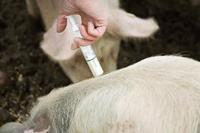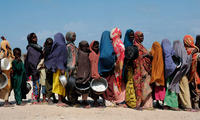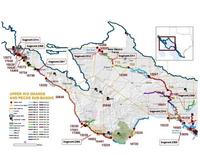-
New anthrax-killing virus could offer new ways to detect, treat, and decontaminate anthrax bacillus
From a zebra carcass on the plains of Namibia in Southern Africa, researchers have discovered a new, unusually large virus (or bacteriophage) which infects the bacterium that causes anthrax. The novel bacteriophage could eventually open up new ways to detect, treat, or decontaminate the anthrax bacillus and its relatives that cause food poisoning. Bacteriophages are often highly specific to a particular strain of bacteria, and when they were first discovered in the early twentieth century there was strong interest in them as antimicrobial agents. The discovery of penicillin and other antibiotics, however, eclipsed phage treatments in the West, although research continued in the Soviet Union.
-
-
Halting bugs’ crop destruction in India saves up to $309 million
Researchers who first discovered a devastating pest in India and devised a natural way to combat it have now put an economic value on their counterattack: up to $309 million the first year and more than $1 billion over five years. This is the amount of damage the papaya mealybug would have wreaked on farmers and consumers in India without scientists’ intervention. The winning intervention centered on three natural enemies of the mealybug — three parasitic wasps from Mexico— which the U.S. government first employed in Florida after the pest spread there in the late 1990s.
-
-
Engineering student develops early detection methods for E. coli bacteria
Currently, it can take several days to detect bacteria in meat. A biomedical engineering graduate student at the University of New Mexico is working on ways quickly to detect Escherichia coli or E. coli bacteria in meat before it reaches the consumer. “If we are able to detect E. coli very early on in the beef chain, for example, in cows that are in the pasture or in beef samples from the slaughterhouse, we can prevent further contamination down the line, thereby mitigating the effect of mass recalls and illness,” she says.
-
-
California lawmakers propose restricting use of antibiotics in livestock

The growth of antibiotic-resistant bacteria in humans has been attributed to the increasing use of antibiotics in livestock. The Centers for Disease Control and Prevention(CDC) estimates that antibiotic-resistant bacteria infect more than two million Americans a year,killing at least 23,000 of them. California legislators are proposing new laws to restrict the use of antibiotics in livestock.
-
-
Economists propose market-driven solutions to the problem of antibiotic use in agriculture
Fifty-one tons of antibiotics are consumed daily in the United States, of which 80 percent are used in agriculture. To minimize the overuse of antibiotics in livestock, Aidan Hollis of the University of Calgary is proposing the imposition of an antibiotic tax on food producers, thus encouraging them to distinguish between good and bad use of antibiotics, since the fee would force farmers to purchase antibiotics only when needed to treat sick animals and not for non-illness purposes.Timothy Richards of Arizona State University says that more regulations or a tax would run the risk of harming the agriculture industry. He says that farmers and ranchers should clearly label their products as containing or not containing antibiotics, and then market dynamics would operate by “letting people follow labels and buy or not buy meats where antibiotics are used.”
-
-
Salmonella biofilms extraordinarily difficult, if not impossible, to kill
In the United States, an estimated million-plus cases of Salmonella occurs annually, with 23,000 hospitalizations and 450 fatalities reported each year. Researchers find that once Salmonella bacteria get into a food processing facility and have an opportunity to form a biofilm on surfaces, it is likely to be extraordinarily difficult, if not impossible, to kill it.
-
-
U.S. conducted bioweapon tests in Japan in early 1960s
The U.S. Army tested biological weapons in Okinawa, Japan in the early 1960s when the United States ruled the prefecture. U.S documents confirmed that the tests, conducted at least a dozen times occurred between 1961 and 1962. The test involved releasing rice blast fungus over rice paddies in order to measure the agent’s effect on production. With hundreds of millions of people dependent on rice as a staple food, failure of rice production could result in mass starvation. The fungus infects crops naturally, and experts estimate it destroys enough rice to feed sixty million people a year.
-
-
Stimulating plant growth and increasing crop yields
Plants naturally slow their growth or even stop growing altogether in response to adverse conditions, such as water shortage or high salt content in soil, in order to save energy. They do this by making proteins that repress the growth of the plant. Growth repression can be problematic for farmers as crops that suffer from restricted growth produce smaller yields. Scientists have discovered a natural mechanism in plants that could stimulate their growth even under stress and potentially lead to better crop yields.
-
-
Europe facing more severe and persistent droughts
Drought is a major natural disaster that can have considerable impacts on society, the environment, and the economy. In Europe alone, the cost of drought over the past three decades has amounted to over 100 billion euros. Europe has been battered by storms in the last few years, but researchers warn that many river basins, especially in southern parts of Europe, are likely to become more prone to periods of reduced water supply due to climate change. An increasing demand for water, following a growing population and intensive use of water for irrigation and industry, will result in even stronger reductions in river flow levels.
-
-
Geoengineering measures to cool the planet would cause climate chaos
Geoengineering — the intentional manipulation of the climate to counter the effect of global warming — is being proposed as a last-ditch way to deal with the problems of climate change. New research suggests geoengineering could cause massive changes to rainfall patterns around the equator, drying the tropical rainforests in South America and Asia, and intensifying periods of drought in Africa.
-
-
Improper use of biocides in food production poses public health risks
Biocides used in the food industry at sublethal doses may be endangering, rather than protecting, public health by increasing antibiotic resistance in bacteria and enhancing their ability to form harmful biofilms, according to a new study.
-
-
Central African Republic, already mired in ethnic violence, faces another threat: famine

Since last year, when they had to flee the intensifying violence across the Central African Republic, farming communities had to abandon their fields along the main roads to replant deep in the bush. This disruption led them to produce much less than in previous years, with a major impact on their food reserves, which will last till February instead of July. The success of the next planting season crucially hinges on the return of farming families to the fields. Families who are unable to plant in March will have to wait one whole year before they can hope to harvest again. Failure to plant in March will have dire consequences for the food security of the Central African Republic’s population.
-
-
Extensive use of antibiotics in agriculture creating public health crisis

In the United States, 80 percent of the antibiotics are consumed in agriculture and aquaculture for the purpose of increasing food production. This flood of antibiotics released into the environment — sprayed on fruit trees and fed to the likes of livestock, poultry, and salmon, among other uses — has led bacteria to evolve.Mounting evidence shows resistant pathogens are emerging in the wake of this veritable flood of antibiotics — resulting in an increase in bacteria that is immune to available treatments. Scientists say that if the problem is left unchecked, this will create a health crisis on a global scale.
-
-
Freshwater loss compounds climate change’s detrimental effects on agriculture
A warmer world is expected to have severe consequences for global agriculture and food supply, reducing yields of major crops even as population and demand increases.Agricultural models estimate that given the present trajectory of greenhouse gas emissions, climate change will directly reduce food production from maize, soybeans, wheat, and rice by as much as 43 percent by the end of the twenty-first century. Now, a new analysis combining climate, agricultural, and hydrological models finds that shortages of freshwater used for irrigation could double the detrimental effects of climate change on agriculturedue to the reversion of twenty to sixty million hectares of currently irrigated fields back to rain-fed crops.
-
-
Upper Rio Grande to experience growing gap between water supply and demand

Increasing temperatures and changes in the timing of snowmelt runoff could impact the amount of water available on the upper Rio Grande in the future, says a news study. Temperatures will increase four to six degrees Fahrenheit by the end of the twenty-first century, according to the climate modeling used in the study. Although the modeling projects that total annual average precipitation in the basin will not change considerably, we are likely to see a decreasing snowpack, an earlier and smaller spring snowmelt runoff and an increase in the frequency, intensity and duration of both droughts and floods.
-
- All
- Regional
- Water
- Biometrics
- Borders/Immig
- Business
- Cybersecurity
- Detection
- Disasters
- Government
- Infrastructure
- International
- Public health
- Public Safety
- Communication interoperabillity
- Emergency services
- Emergency medical services
- Fire
- First response
- IEDs
- Law Enforcement
- Law Enforcement Technology
- Military technology
- Nonlethal weapons
- Nuclear weapons
- Personal protection equipment
- Police
- Notification /alert systems
- Situational awareness
- Weapons systems
- Sci-Tech
- Sector Reports
- Surveillance
- Transportation
Advertising & Marketing: advertise@newswirepubs.com
Editorial: editor@newswirepubs.com
General: info@newswirepubs.com
2010-2011 © News Wire Publications, LLC News Wire Publications, LLC
220 Old Country Road | Suite 200 | Mineola | New York | 11501
Permissions and Policies
Editorial: editor@newswirepubs.com
General: info@newswirepubs.com
2010-2011 © News Wire Publications, LLC News Wire Publications, LLC
220 Old Country Road | Suite 200 | Mineola | New York | 11501
Permissions and Policies
